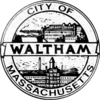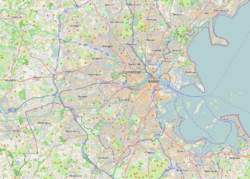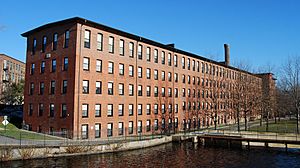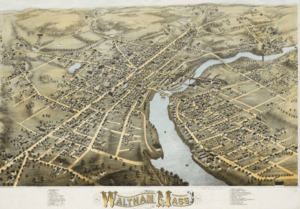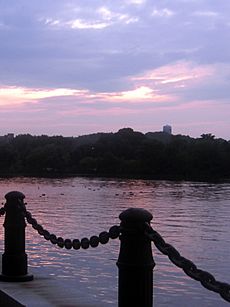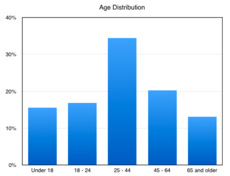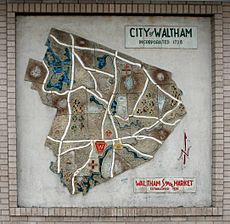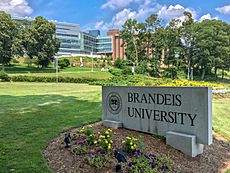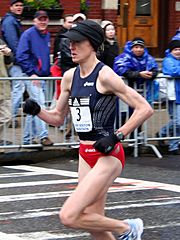Waltham, Massachusetts facts for kids
Quick facts for kids
Waltham, Massachusetts
|
||
|---|---|---|
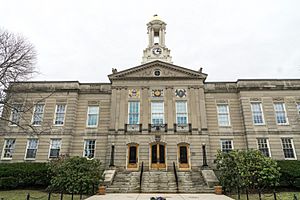
City Hall
|
||
|
||
| Nickname(s):
The Watch City
|
||
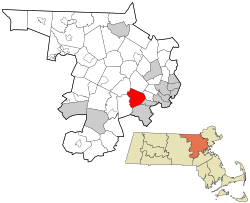
Location in Middlesex County in Massachusetts
|
||
| Country | United States | |
| State | Massachusetts | |
| County | Middlesex | |
| Region | New England | |
| Settled | 1634 | |
| Incorporated as a Town | 1738 | |
| Incorporated as a City | 1884 | |
| Named for | Waltham Abbey, Essex, England | |
| Government | ||
| • Type | Mayor-council city | |
| Area | ||
| • Total | 13.76 sq mi (35.64 km2) | |
| • Land | 12.74 sq mi (33.01 km2) | |
| • Water | 1.02 sq mi (2.63 km2) | |
| Elevation | 50 ft (15 m) | |
| Population
(2020)
|
||
| • Total | 65,218 | |
| • Density | 5,117.95/sq mi (1,975.99/km2) | |
| Time zone | UTC−5 (Eastern) | |
| • Summer (DST) | UTC−4 (Eastern) | |
| ZIP Codes |
02451–02454
|
|
| Area code(s) | 339/781 | |
| FIPS code | 25-72600 | |
| GNIS feature ID | 0612400 | |
Waltham (pronounced /ˈwɔːlθæm/ or WAWL-tham) is a city in Middlesex County, Massachusetts, United States. It was an important place for the labor movement and played a big part in the American Industrial Revolution.
Waltham was the first home of the Boston Manufacturing Company. This city was a model for how industrial cities were planned in the 1800s. It led to a system of work and production called the Waltham-Lowell system. Today, Waltham is a center for research and higher education. It is home to Brandeis University and Bentley University. In 2020, about 65,218 people lived here. Waltham is part of the Greater Boston area, located about 9 miles (14 km) west of Downtown Boston.
People often call Waltham "Watch City." This is because of its connection to the watch industry. The Waltham Watch Company opened its factory in Waltham in 1854. It was the first company to make watches using an assembly line. The company won a gold medal in 1876 at the Philadelphia Centennial Exposition. Before closing in 1957, the company made over 35 million watches, clocks, and other tools.
Waltham shares borders with several other towns. To the east are Watertown and Belmont. Lexington is to the north. To the west are Lincoln and Weston. Finally, Newton is to the south.
Contents
Exploring Waltham's Past
English settlers first came to Waltham in 1634. It was part of Watertown back then. In 1738, Waltham officially became its own town. However, people had lived in this area for thousands of years before Europeans arrived. When Europeans came, Waltham was a border area between the Pawtucket and Massachusett tribes. Native settlements were nearby at Nonantum and Pequosset (Watertown). Early settlers wrote about an "Indian Stockade" near today's Cambridge Reservoir. They also noted an "Indian Hollow" in today's Calvary Cemetery. A native trail through Waltham, called the "Old Connecticut Path," was still used after colonization. It later became the basis for today's Route 20.
Waltham likely got its name from Waltham Abbey in Essex, England. The name first appeared in the town's official papers on January 15, 1738. The name comes from old Anglo-Saxon words: weald or wald meaning "forest," and ham meaning "homestead" or "enclosure." Waltham did not have a clear town center until the 1830s. That's when the Boston Manufacturing Company gave the town land. This land is now its central square.
In the early 1800s, Francis Cabot Lowell and his partners started the Boston Manufacturing Company in Waltham. This was the first textile mill in the United States that did everything in one place. Their goal was to fix problems with quality and shipping in the textile industry. The Waltham-Lowell system of production is named after the city and the mill's founder.
The city has many large, historic homes. These include Gore Place, a mansion built in 1806 for former Massachusetts governor Christopher Gore. There's also the Robert Treat Paine Estate, designed by famous architects for a kind person named Robert Treat Paine, Jr.. The Lyman Estate is a 400-acre (1.6 km2) property built in 1793 by a Boston merchant named Theodore Lyman.
In 1857, the American Watch Company in Waltham made the Waltham Model 1857 watch. Later, in the late 1800s and early 1900s, Waltham was home to the Metz car company. This company built the first production motorcycle in the U.S.
Another important invention in Waltham was the way to mass-produce the magnetron tube. Percy Spencer invented this at Raytheon. During World War II, magnetron tubes were used in radar. Later, they became a key part of microwave ovens.
Waltham was also home to the Walter E. Fernald State School. This was the oldest public institution in the Western Hemisphere for people with developmental disabilities.
How Waltham's Name is Said
The city's name is usually said with the first part stressed: WAWL-tham (/ˈwɔːlθæm/). However, the Waltham watch was often pronounced with a softer sound in the second part: WAWL-thum (/ˈwɔːlθəm/). Long ago, most people said it the British way, "Walthum." But when people from Nova Scotia came to work in the mills, the pronunciation changed. The local way of saying it became more phonetic to help French speakers. Sometimes, the city is even called "The Waltham."
Waltham's Location and Features
Waltham is located at 42°22′50″N 71°14′6″W / 42.38056°N 71.23500°W. It is about 11 miles (18 km) northwest of downtown Boston, Massachusetts. It is also about 3 miles (5 km) northwest of Boston's Brighton area. The main part of the city is Waltham Common. This is where Waltham City Hall and various statues are located. The Common is on Main Street, which also has churches, the Waltham Public Library, and the Post Office.
The Charles River flows through Waltham and has several dams. These dams were used to power textile mills and other factories when the city was first developing.
The city covers a total area of 13.6 square miles (35.2 km2). Of this, 12.7 square miles (32.9 km2) is land and 0.9 square miles (2.3 km2) is water.
Waltham's Neighborhoods
Waltham has many different neighborhoods or villages. Some of these include:
- Angleside
- Banks Square
- The Bleachery
- Cedarwood
- The Chemistry
- Ellison Park
- Gardencrest
- Headyland
- The Highlands
- The Island
- Kendal Green
- Kendall Park
- Lakeview
- The Lanes
- Northeast
- The North Side
- Piety Corner
- Rangeley Acres
- Ravenswood
- Roberts
- Rock Alley
- The South Side
- Warrendale
- West End
- Wildwood Acres
People of Waltham
| Historical population | ||
|---|---|---|
| Year | Pop. | ±% |
| 1790 | 882 | — |
| 1800 | 903 | +2.4% |
| 1810 | 1,014 | +12.3% |
| 1820 | 1,677 | +65.4% |
| 1830 | 1,857 | +10.7% |
| 1840 | 2,504 | +34.8% |
| 1850 | 4,464 | +78.3% |
| 1860 | 6,397 | +43.3% |
| 1870 | 9,065 | +41.7% |
| 1880 | 11,712 | +29.2% |
| 1890 | 18,707 | +59.7% |
| 1900 | 23,481 | +25.5% |
| 1910 | 27,834 | +18.5% |
| 1920 | 30,915 | +11.1% |
| 1930 | 39,247 | +27.0% |
| 1940 | 40,020 | +2.0% |
| 1950 | 47,187 | +17.9% |
| 1960 | 55,413 | +17.4% |
| 1970 | 61,582 | +11.1% |
| 1980 | 58,200 | −5.5% |
| 1990 | 57,878 | −0.6% |
| 2000 | 59,226 | +2.3% |
| 2010 | 60,632 | +2.4% |
| 2020 | 65,218 | +7.6% |
| 2022* | 64,065 | −1.8% |
| * = population estimate. Source: United States Census records and Population Estimates Program data. Source: |
||
In 2020, Waltham had 65,218 people and 23,891 households. The city's population density was about 5,118 people per square mile (1,976 per km²).
About 60.5% of the people were White. 7.6% were Black or African American, and 11.8% were Asian. About 22.3% of the population identified as Hispanic or Latino.
About 13.7% of the population was under 18 years old. The median age was 34 years. The population was 48.3% male and 51.7% female.
The average income for a household was $95,851. About 9.2% of the population lived below the poverty line.
People from Other Countries
In 2020, about 26.6% of Waltham residents were born outside the United States. Many of these residents came from Asia (41.5%) and Latin America (32.7%).
Arts and Fun in Waltham
Waltham is a great place to walk around. Its mix of people, parks, public transportation, stores, and trails gives it a high "walkability" score.
Moody Street in downtown Waltham is full of shops, restaurants, and bars. Its lively nightlife and easy access to the train have attracted many young professionals. Moody Street is also known as "Restaurant Row" because of its many local restaurants. The city even has a free "Tick Tock Trolley" on some evenings. This trolley helps visitors get to parking lots easily.
Since 2020, a large part of Moody Street has been closed to cars from May to October. This allows restaurants to have outdoor dining. This change helped businesses during the COVID-19 pandemic. While restaurants like it, some other businesses on Moody Street, like grocery stores, feel it makes their shops harder to reach.
The Waltham Arts Council hosts "Concerts On Waltham Common" every summer. These free concerts feature different musical groups each week.
The Rose Art Museum at Brandeis University shows modern and contemporary art. Its collections and programs are free for everyone to visit.
Waltham's history is also celebrated in many museums and sites. The Charles River Museum of Industry & Innovation, the Waltham Watch Factory historic district, Gore Place, the Lyman Estate, and the Robert Treat Paine Estate are all on the National Register of Historical Sites. Many festivals, like the annual sheep shearing festival at Gore Place, happen at these places. The National Archives and Records Administration has a branch in Waltham. The Waltham Public Library has many old records about the city's history. The Waltham Museum focuses only on the city's past.
Waltham is also known for its love of books and writing. Local author Jessica Lucci has written books about Waltham. These can be found at the Waltham Museum and other places.
The Waltham Mills Artists Association is located in one of the old Boston Manufacturing Company factories. Every November, the artists open their studios to the public. You can see and discuss art made in many different ways.
The Waltham Philharmonic Orchestra started in 1985. It is a group of nearly 60 musicians. They aim to provide high-quality classical concerts for the community. The orchestra performs several concerts each season. One concert features the winner of the annual Youth Concerto Competition. This gives young musicians a chance to perform with the orchestra.
Waltham is also home to the Waltham Symphony Orchestra. This is a high-level orchestra with 55 musicians. They perform five concerts each season.
The Waltham Land Trust works to protect open spaces in the city.
Waltham celebrates its many cultures with festivals. The annual Latinos en Acción Festival celebrates the city's Puerto Rican, Mexican, Peruvian, and Guatemalan residents. This festival includes a parade, music, food, and a beauty pageant.
In recent years, Waltham has become a center for Ugandan culture. About 1500 Ugandans live in the city, leading some to call it "Little Kampala." The Ugandan North America Association is based here. There is also St. Peters Church of Uganda Boston and a popular Ugandan restaurant called Karibu. A Ugandan immigrant from Waltham, Wilberforce Kateregga, even started Waltham College Uganda. This boarding school in Uganda helps over 300 orphans and children affected by AIDS. He named the school after his new home city.
Places to Visit in Waltham
- Gore Place
- Lyman Estate
- Robert Treat Paine Estate
- Charles River Museum of Industry & Innovation
- Prospect Hill – one of the highest points in the region
- Charles River – with a Riverwalk on Moody St.
- A. Wherehouse
- Rose Art Museum
- Metropolitan State Hospital (Massachusetts)
- Norumbega Tower
- American Waltham Watch Company Historic District
- Mass Central Rail Trail—Wayside
Waltham's Economy
Many companies have their main offices in Waltham. These include medical technology company PerkinElmer and biopharmaceutical services provider Paraxel. Other companies are energy supplier Global Partners, data services provider Lionbridge, and financial firm Commonwealth Financial Network. Technology companies like Care.com and StudentUniverse are also here. Education Development Center (EDC) and Thermo Fisher Scientific are also based in Waltham. The marketing company Constant Contact is another major employer.
Retail stores are mostly found on Main Street, Moody Street, Lexington Street, River Street, and parts of Route 60. A former Polaroid site has also been developed for new stores.
Learning in Waltham
Colleges and Universities
Waltham is home to two universities:
- Bentley University
- Brandeis University
Public Schools
The Waltham Public Schools system has seven elementary schools. These are Northeast, Fitzgerald, MacArthur, Plympton, Whittemore, Stanley, and the Waltham Dual Language Elementary School. There are two middle schools: McDevitt and Kennedy. The city also has one high school, Waltham High School.
Waltham High School's sports teams are called the Hawks. They were once known as the Watchmen and the Crimson.
Private Schools
- Chapel Hill – Chauncy Hall School
- Gann Academy – The New Jewish High School of Greater Boston
- Our Lady's Academy (Pre-K through 8)
Getting Around Waltham
Transportation
Waltham is close to several major highways. Interstate 95 (also known as Route 128) runs through the western part of the city. Interstate 90, which is the Massachusetts Turnpike, is just south in Newton. Many state highways are also nearby.
The MBTA commuter rail has two stops in Waltham on the Fitchburg-Boston Line. One stop is in Central Square Waltham, across from City Hall. The other is near Brandeis University.
MBTA bus service also covers the city with several routes.
The Charles River flows through Waltham. Bike and walking paths cover most of the south bank. They also cover part of the north bank from Prospect Street to Moody Street. Some people ride these paths to work in Cambridge and Boston.
Fire and Medical Services
The city of Waltham is protected by the Waltham Fire Department (WFD). This department has 166 full-time firefighters. It was started in 1816. The department has divisions for putting out fires, preventing fires, and training.
Armstrong Ambulance Service provides emergency medical services to Waltham 24 hours a day, 7 days a week.
Waltham in the News
Waltham has its own weekly newspaper, the Waltham News Tribune. It is published every Thursday. The Waltham Patch covers local daily news online. It also lets local people post their own blogs and events. WCAC-TV is the local cable access channel. It helps community members learn to create their own TV shows about local topics. News about Waltham sometimes appears in The Boston Globe's GlobeWest section.
Waltham used to be home to the classical radio station WCRB (99.5 FM). It moved to Boston in 2006. Brandeis University has its own low-power radio station, WBRS (100.1 FM).
Famous People from Waltham
- Luther Atwood, chemist
- Keith Aucoin, hockey player
- F. Lee Bailey, lawyer
- Nathaniel Prentice Banks, Civil War General and Governor of Massachusetts
- Anya Battaglino, professional hockey player
- Mackenzy Bernadeau, NFL football player
- Suzanne Brockmann, author
- Rob Chiarelli, Grammy Award winner
- JP Dellacamera, sports commentator
- Ryan Gallant, professional skateboarder
- Alan Griffin, professional basketball player
- James N. Hallock, scientist
- John Peabody Harrington, ethnologist and linguist
- Sophie Chantal Hart, professor
- Lorenza Haynes, librarian, minister, writer
- Clarence Hobart, tennis champion
- Abbie Hoffman, political activist
- C. D. Howe, Canadian politician
- Gail Huff, television reporter
- Deena (Drossin) Kastor, Olympic marathon runner
- Pauline R. Kezer, former Secretary of the State of Connecticut
- John Leary, Major League Baseball player
- Jeff Lazaro, former Boston Bruins hockey player
- Samuel Livermore, United States Senator
- John Lynch, Governor of New Hampshire
- Shawn McEachern, Boston Bruins hockey player
- Paul Moody, inventor
- Angelo Mosca, football player and wrestler
- Richard Thomas Nolan, writer and professor
- Dave Pino, musician
- Tom Rooney, racing driver
- Ida Annah Ryan, first woman to earn a master's degree in architecture from MIT
- Evelyn Sears, U.S. Open tennis champion
- Fred Smerlas, NFL football player
- Caroll Spinney, puppeteer for Big Bird and Oscar the Grouch
- Edward Royal Warren, naturalist and engineer
- Mary Watson Whitney, astronomer
- Bob Weston, musician
- Chris Wilson, guitarist
- Gordon S. Wood, Pulitzer Prize winner
- Franz Wright, Pulitzer Prize-winning poet
- Paramahansa Yogananda, author
See also
 In Spanish: Waltham (Massachusetts) para niños
In Spanish: Waltham (Massachusetts) para niños


